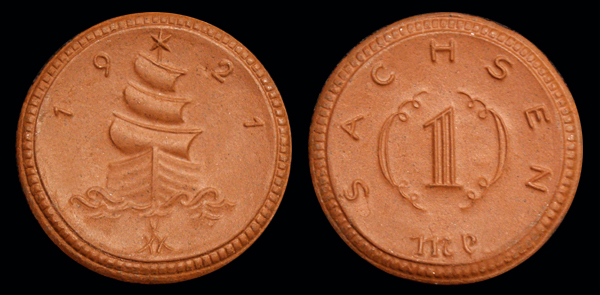
SACHSEN (SAXONY) 1 MARK 1921
M- 11928.13 Saxony 1 Mark Porcelain Coin Depicting Ship Minted by Meissen Porcelain Works.
This is a reddish brown stoneware coin minted by the famous porcelain works at Meissen in Germany. This coin displays the crossed swords found on every product of the Meissen porcelain works since 1722 including the white and brown porcelain coins and medals minted during this time. Although both white and brown porcelain coins and medals were produced, brown porcelain was often preferred over white for circulation due to the fact that it was less effected by dirt, breakage and wear.
Although the use of porcelain for coins and medals was not a new concept as Meissen had produced its first porcelain medallion as far back as 1710, regular production of German porcelain coins as currency for a variety of towns, cities, and regains (emergency money and donation coins) began at the end of 1920 and in the first months of 1921.
A limited number of these coins were produced from plaster casts for Germany and for the State of Saxony. These earlier limited issue coins are remarkable for having finer, less sharp lines, rougher surfaces and are thinner than the ones later minted from steel moulds. Later issues such as the one pictured above were produced in large numbers from steel casts and are characterized by thicker flans and sharper detail.
Porcelain coins with face values from 10 pfennigs to 20 marks were issued in a variety of types and numbers for many German cities and regions at the beginning of the 1920s. Although these coins were reportedly very popular do to their attractive, interesting and varied designs, they were impractical as coinage do to the fact that they broke rather easily and did not hold up the rigors of circulation for long. They ultimately failed as currency thus circulation of these coins was very limited though commemorative and special issue porcelain coins and medals continued to be produced.
The Free State of Saxony (Sachsen) is the easternmost federal state of Germany. Located in the country's southeast, it is the tenth-largest in area and sixth-largest in population among Germany's sixteen states with a population of 4.3 million.
Saxony has a long history as a duchy, an electorate of the Holy Roman Empire and of the German Nation (the Electorate of Saxony), and eventually as a kingdom (the Kingdom of Saxony). Its monarchy was overthrown in 1918 and a republican form of government was established under its current name subsequent to Germany's defeat in World War I. Abolished during communist rule, it was re-established in 1990 during the re-unification of east and west Germany.
During the early Middle Ages the term Saxony referred to the region occupied by today's states of Lower Saxony and northern North Rhine-Westphalia. The Saxons had migrated there from the area of present-day Schleswig-Holstein between 250 and 500.
